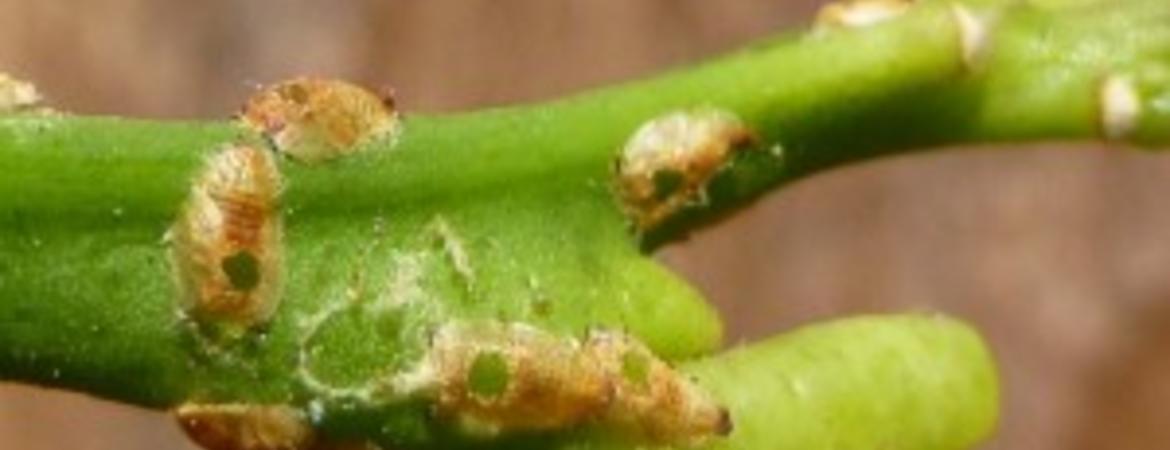
|
Written by: Photos by: |
The Problem: Since its accidental introduction in 2008, the invasive Asian Citrus Psyllid (ACP) is now widespread throughout southern CA including San Diego, Imperial, Riverside, Los Angeles, Orange, and San Bernardino counties. ACP may present the greatest economic threat that California’s citrus industry has ever faced. This little insect is an efficient vector of a bacterium that causes a lethal citrus disease, huanglongbing (HLB), which is one of the most destructive diseases of citrus worldwide. There is currently no cure for this bacterial disease which kills susceptible commercial citrus varieties in as little as 5-8 years. California’s citrus industry is currently valued at $2 billion per year. Since 2005, Florida’s citrus industry has been hit hard by HLB. The spread of HLB in Florida by ACP has been estimated to have cost the Florida citrus industry $1.6 billion in losses over a 5 year period. In April 2012, the first case of HLB was detected in a residential site in Los Angeles County.
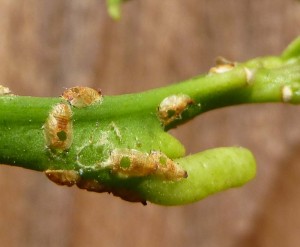
Ongoing Biocontrol Efforts: To reduce the spread of HLB into California’s commercial orange groves, a tiny parasitic wasp, Tamarixia radiata, sourced from Pakistan is currently being massed reared and released as a biocontrol agent throughout southern California. As of July 2014, approximately ~700,000 Tamarixia wasps have been released by the California Department of Food and Agriculture. This parasitoid has multiple stable populations and has even spread to sites where it was never released and it had likely established in southern California. Despite these massive rearing and distribution efforts, the efficacy of Tamarixia in controlling urban ACP population growth and spread remains unknown. Preliminary results of biweekly ACP surveys across 27 sites in Riverside and LA County suggest that Tamarixia may be limiting ACP densities.
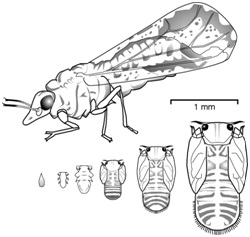
ACP Life Cycle: ACP hatch from eggs and transition through 5 juvenile life stage known as nymphal instars before reaching adulthood (see photo above). ACP adults have wings and are excellent fliers. ACP generation time is short with development from egg to sexually mature adult taking ~2-4 weeks.
Natural Enemies and Allies: In addition to Tamarixia, ACP may have other enemies including naturally occurring predators. Generalist predators, including lady beetles are known to signficantly reduce ACP numbers in Florida, but their impact in California is unknown. To complicate matters further, the Argentine ant, another invasive pest, may be helping ACP thrive in southern CA. These ants have been observed to protect ACP colonies from their enemies (including Tamarixia). In exchange, colonies of ACP nymphs provide ants with honeydew, a sweet waste product that nymphs excrete (See photo above).
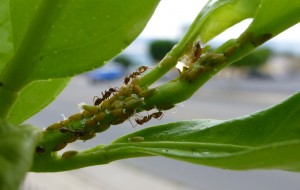
ACP Survival Experiments: To access the impact of natural enemies on ACP population growth, experimental ACP cohorts are currently being monitoring at three sites within Riverside County, CA where Tamarixia has been released and established. ACP cohorts of ~200 eggs are established in the lab on four citrus plants that are placed at field sites to assess the impact of natural enemies on these experimental ACP cohorts. Four treatments are evaluated to assess natural enemy impact on immature ACP: (1) potted plants are completely enclosed with a fine mesh bag to exclude all natural enemies, this treatment acts as a control to determine ACP survivorship rates in the absence of natural enemies (we expect survivorship rates to be high in this treatment is nothing is able to access the ACP and feed on it). (2) Potted plants are enclosed within a coarse mesh bag to prevent access by large predators while still allowing entry of small natural enemies like Tamarixia. This treatment provides information on how much mortality Tamarixia alone can inflict on ACP if these parasitoids can find ACP cohorts in the field. (3) A sticky barrier is applied to potted plant bases to prevent access to ACP by walking natural enemies (e.g., lacewing larvae). Only natural enemies that can fly (e.g., ladybugs and Tamarixia) will be able to land on plants to attack ACP eggs and nymphs, (4) Potted plants are fully exposed thereby allowing free access to ACP life stages by all natural enemies (i.e., walkers and flyers). Plants are examined every other day using a 10x lens and numbers of ACP by life stage are recorded per treatment. Predators observed on ACP patches or trapped in tangle foot barriers are identified. Parasitism by Tamarixia is easy to detect in the field since emerging adult wasps leave a circular exit hole in the body of the deceased ACP host (see photo above).
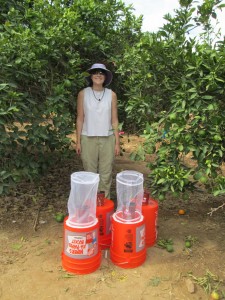
Results to Date: Preliminary results suggest that both predators and Tamarixia reduce experimental ACP numbers in California. Protection from natural enemies can increase ACP survival by 6-fold. Thus far, hover fly (Syrphidae) and green lacewing (Chrysopidae) larvae have been the most commonly observed predators, but spiders (Aranae) and lady beetles (Coccinellidae) have also been seen on experimental ACP colonies. Hover fly and green lacewing larvae have voracious appetites and may consume over 100 ACP nymphs before pupating (the non-feeding stage between insect larvae and adult life stages). ACP mortality from these hungry larvae can reach as high as 93% in some instances.
One experimental site with ACP cohorts in Riverside exhibited a 66.3% parasitism rate by Tamarixia when ACP cohorts were protected from walking predators and only a 1.4% parasitism rate when exposed to all enemies. Could this reduction in parasitism be the work of the Argentine ant? These ants have been observed tending experimental ACP colonies which likely protects them from natural enemies.
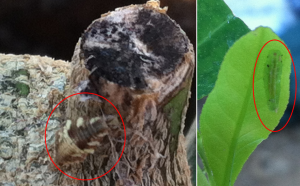
Future Plans: Argentine ants are abundant at all experimental sites and their interactions with ACP and natural enemies are being investigated. These experiments will continue over a year’s time (2014-2015) to compare seasonal variation in ACP densities through time.
Take Home Message: Our results suggest that predators as well as Tamarixia are helping limit ACP numbers at urban sites. In turn, your friendly neighborhood insects may help prevent the future spread of HLB in California by reducing ACP populations and this in turn helps to protect our commercial citrus production areas from ACP and HLB.
